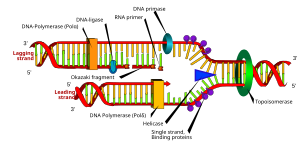DNA replication
DNA replication is the transfer of information fromDNA to DNA. It is therefore a heritable ability.
General characteristics[edit | edit source]
During replication, two identical daughter DNA molecules are formed from one parent DNA molecule - each with one strand from the original DNA, so this is a semi-conservative process , where the newly created double helix always has one original strand and the other newly synthesized strand . It is used during reproduction, when it ensures the identity of the genetic information of both daughter cells (for reproduction, it is necessary for the offspring to receive full genetic information). The rate of replication in animal cells is estimated to be 0.5-0.15 μm/min, it is a really slow process, therefore it takes place in many places at the same time.
The process of replication[edit | edit source]
The sites where replication occurs are called replicons. The number of replicons in a cell is not constant , there are more in rapidly multiplying cells than in slowly multiplying cells. Replication does not occur on all replicons at the same time , generally it starts later in replicons located in heterochromatin. Enzymes called DNA polymerases play a key role in DNA replication. There are 5 types of enzymes known as DNA-dependent DNA polymerases in humans (in animal cells there are five types).
The following applies to all types of DNA polymerases:
- They need a matrix = a strand to which they make a complement according to the base complementation rules;
- during the process they always proceed from the 5' end to the 3' end;
- the free end of the 3' nucleotide needs to be available, so the phosphodiester bond can attach to the 5' place of the newly inserted nucleotide. The newly added nucleotides are used in the form of nucleotide triphosphates, by splitting two macroergic bonds. This way the necessary energy is obtained to make the bond;
- DNA polymerase cannot initiate synthesis de novo, however can only add new nucleotides at the 3' end position of the previous nucleotide;
- in order for DNA polymerase to begin adding nucleotides to the new DNA strand, the hydrogen bonds (i.e., the low-energy bonds between the two strands) must first be broken by the helicase enzyme.
The sites that arise after helicase disruption are referred to as origins of replication. Replication origins are formed by specific sequences of nucleotides that are recognized by initiation proteins (initiation factors). For easy separation of the strands, these sequences contain a high proportion of adenine and thymine. In bacteria , we would find only one such origin .
Human DNA creates around 10,000 replication origins, which enables it to replicate itself in a relatively short time. Primase ( DNA-dependent RNA polymerase ) creates a short RNA primer ("a loop") at the beginning of the replicated section of the new DNA strand - to its 3' end DNA polymerase can attach the first nucleotide of the new DNA strand. Since both DNA strands are antiparallel (the 5' end of one strand corresponds to the 3' end of the other strand) and since DNA polymerase synthesizes "unidirectionally" (from 5' to 3'), replication can only proceed continuously on one strand. On this strand, therefore, replication (which is carried out by δ-polymerase ) takes place faster and the strand is referred to as the leading strand. On the second (delayed) strand, replication takes place in parts - so-called Okazaki fragments are formed ← replication here is slower, it is carried out by α-polymerase , which has primase activity.
In addition to the mentioned DNA polymerases, a number of enzymes are involved in the replication process, whose role is:
- to develop a suprahelical structure - gyrase ;
- to unfold the Watson-Crick double helix – helicase.
After new strands are synthesized to the original (template) strands, DNA replication is complete.
DNA polymerase makes 1 mistake in about 107 replicated bases (theoretically, G – T and A – C pairs can also form, but they are much less stable). In addition, the DNA polymerase itself has a correction function (in the event of an error, the DNA polymerase corrects itself by cutting out the incorrect base and replacing it with the correct one), with this method, the RNA loops are also most likely removed. After this the enzyme ligase joins the individual fragments into a continuous chain.
Links[edit | edit source]
Související články[edit | edit source]
External links[edit | edit source]
Zdroj[edit | edit source]
- ŠTEFÁNEK, Jiří. Medicine, diseases, studies at the 1st Faculty of Medicine, UK [online]. [feeling. 2/11/2010]. < https://www.stefajir.cz/ >
- BRUCE, Alberts, D BRAY and A JOHNSON, et al. Basics of cell biology. 1st edition. Ústí nad Labem: Espero Publishing, 1998. 630 pp. ISBN 80-902906-0-4.
|
This article was marked by its author as Under construction, but the last edit is older than 30 days. If you want to edit this page, please try to contact its author first (you fill find him in the history). Watch the discussion as well. If the author will not continue in work, remove the template Last update: Sunday, 19 Feb 2023 at 4.06 pm. |



